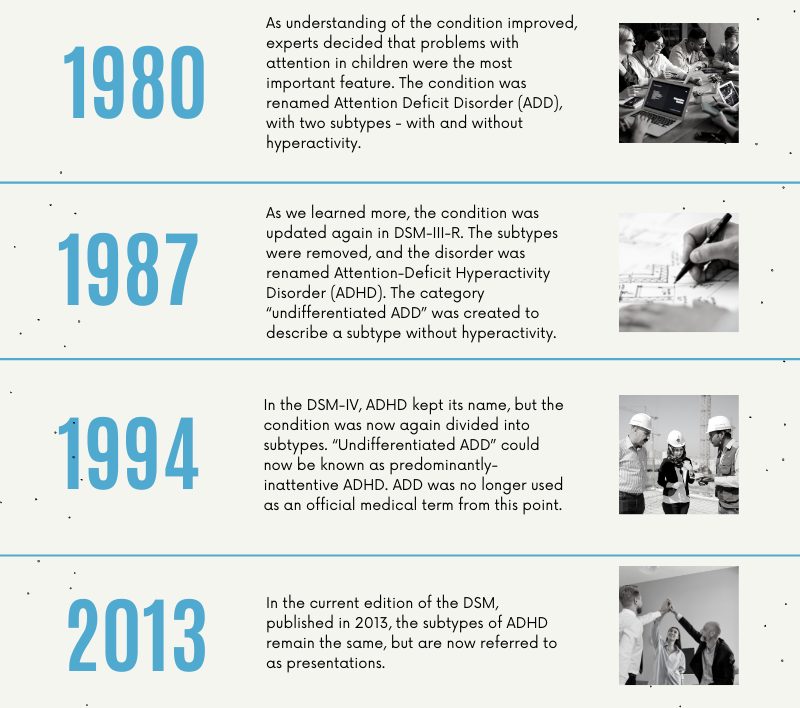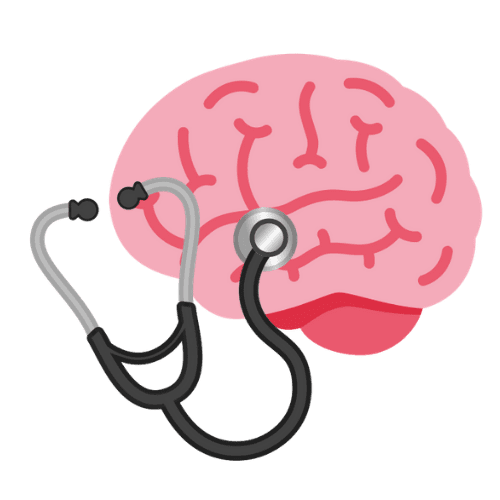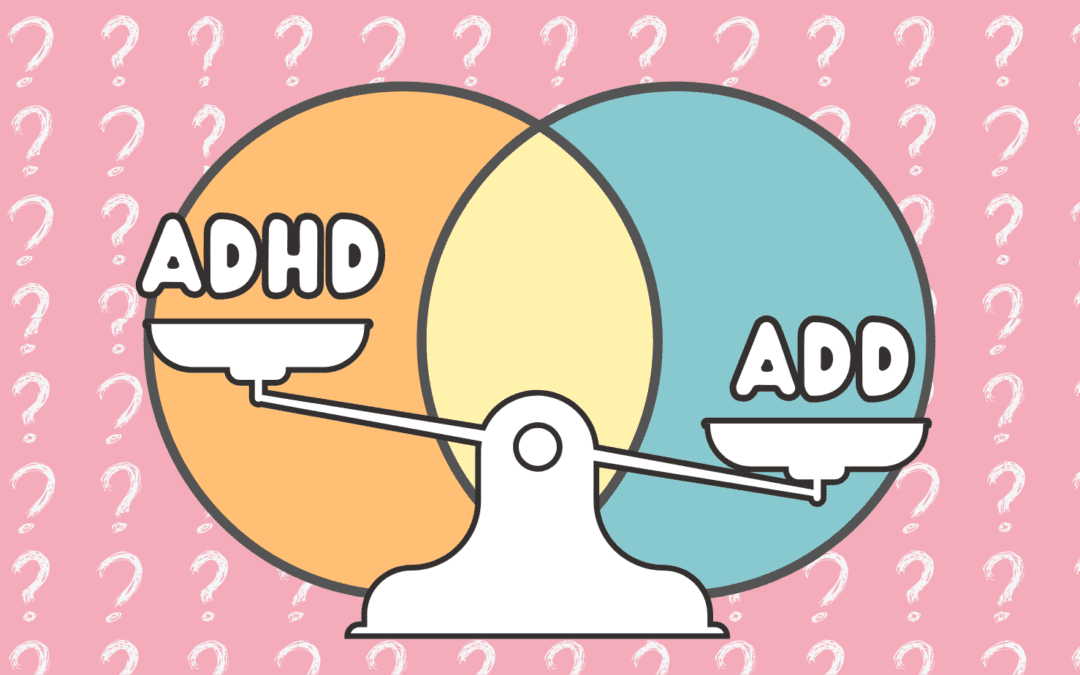Have you heard both the terms ADHD (attention-deficit hyperactivity disorder) and ADD (attention-deficit disorder) used interchangeably, and are wondering if they are the same thing?
The short answer is yes – ADHD and ADD are the same disorder.
However, they do have small differences, related to our most predominant symptoms. So why do we have two names for what is essentially the same condition? Is one more appropriate than the other? The answer lies in the history of ADHD, and its naming throughout the years.
The History of ADHD / ADD
Attention and its Diseases
Although ADHD is now one of the most prevalent psychiatric diagnoses, its features were only first loosely described in 1798 by Alexander Crichton, a Scottish doctor.
In a book chapter named “On Attention and its Diseases”, he describes a condition as such:
When born with a person it becomes evident at a very early period of life, and has a very bad effect, inasmuch as it renders him incapable of attending with constancy to any one object of education. But it seldom is in so great a degree as totally to impede all instruction; and what is very fortunate, it is generally diminished with age.
Alexander Crichton, 1798
This quotation seems to describe something similar to the presentation of inattentive ADHD symptoms in childhood. However, the physician did not note any hyperactive or impulsive symptoms.
A Defect of Moral Control
Later, in 1902, a British paediatrician named Sir George Still gave three lectures to the Royal College of Physicians of London. These lectures were titled “On Some Abnormal Psychical Conditions in Children”. In one, Still discussed psychiatric conditions which he believed to be “an abnormal defect of moral control in children”.
His description of these cases are today considered to be historical descriptions of ADHD. The children were noted to have a “defect of moral control as a morbid manifestation, without general impairment of intellect and without physical disease”.
Interestingly, these cases also displayed “a quite abnormal incapacity for sustained attention”. The lectures are considered by many to be the first clear historical record of ADHD / ADD.
Hyperkinetic Reaction of Childhood
The first name for the collection of characteristics that we now know as ADHD / ADD was not recorded until 1968. The symptoms were described as being “characterised by overactivity, restlessness, distractibility, and short attention span”.

They appeared in the American Psychiatric Association’s DSM-II (Diagnostic and Statistical Manual of Mental Disorders), and were used to diagnose a condition called “Hyperkinetic Reaction of Childhood”.
Attention Deficit Disorder (ADD)
As understanding of the condition improved, experts decided that problems with attention in children were the most important feature. Additionally, inattentive symptoms responded best to a newly-available medication – Ritalin. As a result, when the DSM-III was published in 1980, Hyperkinetic Reaction of Childhood was given a new name.
From this point, it was to be known as Attention Deficit Disorder – which is where the name ADD comes from. Although hyperactivity was not yet part of the name, the manual added that hyperactivity could occur alongside ADD, but was not necessary for a diagnosis. This created two subtypes of ADD – with and without hyperactivity.
Attention Deficit Hyperactivity Disorder (ADHD)
Debates around the importance of different symptoms continued. It is important to note that there was not a lot of research on ADHD / ADD when it was renamed Attention Deficit Disorder in 1980.
As we learned more about the condition, the information about it was updated again in DSM-III-R, in 1987.
The subtypes were removed. The previous symptom domains of inattention, impulsivity and hyperactivity were combined into a single list, with just one cut-off score.
Most significantly, the disorder was renamed Attention-Deficit Hyperactivity Disorder (ADHD).
ADD was still in use, however. The category “undifferentiated ADD” was created to describe the subtype previously known as ADD without hyperactivity.

ADHD and ADD
Throughout the 1980s, our scientific understanding of the disorder greatly improved. Some of this work focused on the subtypes of ADD. Novel neuroimaging techniques helped us to find evidence of structural abnormalities in the brains of children with ADHD. A genetic component was also found, and it was finally recognised that ADHD could persist into adulthood.
In 1994, the DSM-IV was published. In this edition, ADHD kept its name, but the condition was now again divided into subtypes. These were predominantly inattentive symptoms, predominantly hyperactive and impulsive symptoms, and a subtype with a combination of all groups of symptoms.
At this point, the DSM stopped using the name ADD altogether. “Undifferentiated ADD” could now be known as predominantly-inattentive ADHD.
In the current edition of the DSM, published in 2013, the subtypes of ADHD remain the same, but are now referred to as presentations.
So why do we still use both ADHD and ADD for the same condition?
ADHD is now the official, medical name for the disorder.
Although ADD was the official name for only 7 years, between 1980 and 1987, it is still used by many people today. The reason for this isn’t necessarily a lack of understanding.
There are many members of the ADHD community who feel that the H (hyperactivity) doesn’t describe them appropriately, as they have predominantly-inattentive type symptoms. This can be especially the case for adult women, whose symptoms are known to commonly present in a different way than those of men.
Some adults don’t like the term ADHD because they feel that it evokes a stereotype of a hyperactive child, which may lead to stigmatising behaviour from others.
The difference is sometimes explained as a question of whether you are a daydreamer (ADD) or a fidgeter (ADHD).
Should I use ADHD or ADD?
It is absolutely your choice!
Although the majority use ADHD now, no one really minds which you use. Healthcare professionals will also understand the term ADD. In fact, some clinicians use ADD and ADHD interchangeably, in relation to the appearance of hyperactive symptoms.
Treatment of symptoms will be the same, regardless of which term you choose to identify with.
If you want to find current, up-to-date information and news, it may be better to use the term ADHD. Although ADD is valid, it is usually considered outdated by the media and by providers of health information. A majority of the online discussion on social media will also use ADHD.

